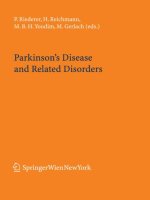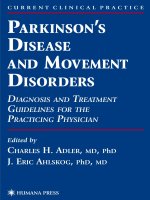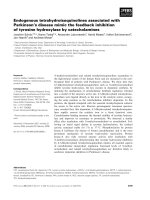Living Well with Parkinson’s potx
Bạn đang xem bản rút gọn của tài liệu. Xem và tải ngay bản đầy đủ của tài liệu tại đây (1.46 MB, 242 trang )
TeAM
YYePG
Digitally signed by TeAM YYePG
DN: cn=TeAM YYePG, c=US,
o=TeAM YYePG, ou=TeAM
YYePG, email=
Reason: I attest to the accuracy
and integrity of this document
Date: 2005.06.27 17:49:45 +08'00'
Living Well
with Parkinson’s
ffirs.qxd 12/28/04 9:46 AM Page i
ffirs.qxd 12/28/04 9:46 AM Page ii
Living Well
with Parkinson’s
SECOND EDITION
Glenna Atwood
with
Lila Green Hunnewell and Roxanne Moore Saucier
Foreword by Robert G. Feldman, M.D.
Professor and Chairman Emeritus, Department of Neurology
Boston University School of Medicine
John Wiley & Sons, Inc.
ffirs.qxd 12/28/04 9:46 AM Page iii
Copyright © 1991, 2005 by Glenna Wotton Atwood, Lila Green Hunnewell, and
Roxanne Moore Saucier. All rights reserved
Published by John Wiley & Sons, Inc., Hoboken, New Jersey
Published simultaneously in Canada
No part of this publication may be reproduced, stored in a retrieval system, or
transmitted in any form or by any means, electronic, mechanical, photocopying,
recording, scanning, or otherwise, except as permitted under Section 107 or 108 of
the 1976 United States Copyright Act, without either the prior written permission
of the Publisher, or authorization through payment of the appropriate per-copy fee
to the Copyright Clearance Center, 222 Rosewood Drive, Danvers, MA 01923,
(978) 750-8400, fax (978) 646-8600, or on the web at www.copyright.com. Requests
to the Publisher for permission should be addressed to the Permissions Department,
John Wiley & Sons, Inc., 111 River Street, Hoboken, NJ 07030, (201) 748-6011, fax
(201) 748-6008.
The information contained in this book is not intended to serve as a replacement for
professional medical advice. Any use of the information in this book is at the
reader’s discretion. The author and the publisher specifically disclaim any and all lia-
bility arising directly or indirectly from the use or the application of any informa-
tion contained in this book. A health-care professional should be consulted regard-
ing your specific situation.
For general information about our other products and services, please contact our
Customer Care Department within the United States at (800) 762-2974, outside the
United States at (317) 572-3993 or fax (317) 572-4002.
Wiley also publishes its books in a variety of electronic formats. Some content that
appears in print may not be available in electronic books. For more information
about Wiley products, visit our web site at www.wiley.com.
Library of Congress Cataloging-in-Publication Data:
Atwood, Glenna Wotton, date.
Living well with Parkinson’s / Glenna Atwood, with Lila Green
Hunnewell and Roxanne Moore Saucier / foreword by Robert G.
Feldman.—Second edition
p. cm.
Includes bibliographical references and index.
ISBN 0-471-28223-5 (pbk.)
1. Atwood, Glenna Wotton, date. 2. Parkinson’s disease—Popular
works. I. Hunnewell, Lila Green. II. Saucier, Roxanne Moore, date.
III. Title.
RC382.A88 2005
616.8Ј33—dc22
2004028305
Printed in the United States of America
10 9 8 7 6 5 4 3 2 1
ffirs.qxd 12/28/04 9:46 AM Page iv
To Blaine, my love
ffirs.qxd 12/28/04 9:46 AM Page v
ffirs.qxd 12/28/04 9:46 AM Page vi
Contents
Foreword by Dr. Robert G. Feldman ix
Preface to the Second Edition by Blaine Atwood xi
Preface to the First Edition xiii
Acknowledgments xv
Chapter 1 Do Not Disturb! 1
Chapter 2 It’s Not Fair! 9
Chapter 3 Coping with Frustration: Practical 15
Suggestions for Everyday Living
Chapter 4 Nutrition That Affects Our Lives 33
Chapter 5 Exercise, the Means to an Active Life 50
Chapter 6 Attitude Makes All the Difference 56
Chapter 7 Doctors and Other Health Professionals 64
Chapter 8 Medications and Therapies 74
Chapter 9 Spouses—Special and Otherwise 99
Chapter 10 Relationships with Our Adult Children 117
Chapter 11 Out of the Mouths of Babes . . . 130
Chapter 12 One Day at a Time! 139
Chapter 13 With a Little Help from My Family 152
and Friends
vii
ftocqxd 12/28/04 9:47 AM Page vii
Chapter 14 Support Groups: Where You Learn What 158
Your Doctor Hasn’t Time to Tell You!
Chapter 15 Is There Life with Parkinson’s? 171
Appendix A Parkinson’s Self-Help Organizations 191
in the United States
Appendix B American Parkinson Disease Association 194
Information and Referral Centers
Appendix C Parkinson’s Organizations in Canada 202
Appendix D Sources of Adaptive Equipment, Clothing, 204
and Other Good Things
Appendix E Bibliography for Chapter 8: Medications 209
and Therapies
Appendix F General Bibliography (Not Including 215
Sources for Chapter 8)
Index 219
viii contents
ftocqxd 12/28/04 9:47 AM Page viii
Foreword
Glenna Atwood shared her experiences and insights about how
she and her family coped with Parkinson’s disease in the first edi-
tion of Living Well with Parkinson’s.
Her words were educational and inspirational to many people
affected by this intrusion in their life’s plan. Glenna, with Blaine—
her husband and best friend—have spoken to audiences through-
out North America, sharing information on how to get the most
out of their doctor, their medications, and each day of their lives.
The inevitable progression of Parkinson’s disease in Glenna pro-
vided more challenges to meet and deal with for the Atwoods.
One problem encountered by patients is simply getting older and
living with concurrent illnesses. In addition to Parkinson’s, Glenna
had a cardiac condition, which eventually caused her death. The
second edition of this book includes her ideas and insights on liv-
ing with advanced Parkinson’s disease.
Each person with Parkinson’s has his or her unique experi-
ences, which require an individually tailored plan. What is univer-
sal in Parkinson’s disease is the need for each person to learn and
understand as much as possible about this condition, as this knowl-
edge leads to more effective coping, proper management, and ther-
apeutic success. This second edition of Living Well with Parkinson’s
provides invaluable information about the many additional med-
ications, surgical interventions, and nutritional and physical ther-
apy approaches that have been introduced for the care of patients
ix
flast.qxd 12/28/04 9:47 AM Page ix
with Parkinson’s since the landmark discovery of levodopa. Armed
with lessons learned from physicians, nurses, and other patients,
people affected by Parkinson’s need not be victims of the process.
—Robert G. Feldman, M.D.
Chairman Emeritus, Department of Neurology,
Professor of Neurology, Pharmacology,
and Public Health,
Boston University School of Medicine,
Director, American Parkinson Disease
Association Advanced Center for Research
at Boston University,
Medical Director, APDA Information and
Referral Center
x foreword
flast.qxd 12/28/04 9:47 AM Page x
Preface to the
Second Edition
For those of you who already know that Glenna passed away, as
well as for people who are meeting her for the first time in this
book, I would like to share a little of her story.
Glenna had Parkinson’s for about twenty years but never gave
up living. A year after her diagnosis, she retired from teaching
so that we could do some of the things we had planned for later
in life.
We financed a motor home and traveled to many places in this
country that we had always wanted to see. In fact, Glenna wrote
most of the first edition of this book while we were on the road. She
usually wrote in the morning while her medicine was most effective.
We talked about ideas, and she wrote while I drove. This was
great for her, because we could plan the day around how she felt,
with no phone calls or other interruptions.
As a result of the public response to the first edition, we were
asked to speak to groups throughout most of the United States
and parts of Canada. Again, we traveled by motor home, this time
visiting people who had written to Glenna after reading the book.
She was always eager to go to the mailbox to discover who
had written to her, and from where. She received letters not only
from people in the United States but from those living in Europe
xi
flast.qxd 12/28/04 9:47 AM Page xi
xii preface to the second edition
and as far away as Australia and New Zealand. Glenna always tried
to answer each letter.
As you will see, she didn’t let Parkinson’s get her down. In fact,
we worked on the book’s revision in a campground in Florida.
She and I still ran the Parkinson’s support group that we started
more than eighteen years ago. She remained busy on committees,
in church, and by planning special events with her grandchildren.
They were her pride and joy.
It wasn’t Parkinson’s but other health problems that limited
Glenna at the end. In fact, she died of a heart attack.
She was the greatest of copilots. I always told her that she made
my world go around.
Be like Glenna—try to live your life to the fullest.
—Blaine Atwood
flast.qxd 12/28/04 9:47 AM Page xii
Preface to the
First Edition
This is the book that I wish I could have found when my Parkin-
son’s was diagnosed in 1981. At the time, very little information
was available for the layperson, and the little that existed was very
depressing. What I wanted to find was a source of information
that would help me understand Parkinson’s, that would give me
an opportunity to relate to someone who has managed well in the
same situation, and that would leave me with reasons to maintain
a positive attitude.
This is my personal story: how I have coped and how I con-
tinue to cope positively as a person living with Parkinson’s. It is
interwoven with facts about managing Parkinson’s as I have learned
them since my diagnosis, through
• Evaluating my own experiences
• Reading the current scientific literature
• Attending workshops, conferences, and symposia
• Participating actively in a support group
• Talking with other people who have Parkinson’s
My Parkinson’s specialist, Dr. Robert G. Feldman, and his
knowledgeable team in the Parkinson’s Program at Boston Medical
xiii
flast.qxd 12/28/04 9:47 AM Page xiii
Center (which is affiliated with Boston University School of Med-
icine) have also contributed significantly to my education.
In this book, I attempt to present the facts while, at the same
time, sharing the ups and downs of my daily life as someone who
has Parkinson’s. I could not share my story without also relating
some of the experiences of my family and friends, since they are
so much a part of my life.
My hope is that all people with Parkinson’s will find hope and
guidance here: that this book may encourage them to say, “Here
is a person who has had Parkinson’s for twenty years, and she and
her family are living happy, productive lives. If she can do it, I can
do it.”
Parkinson’s is a progressive disease. A cure is yet to be found.
But with current medications and therapies, and the proper per-
sonal care, there is reason to believe that a person with Parkin-
son’s can live a satisfying life. New medications and other scien-
tific breakthroughs are making a great impact on the quality of
our lives while we await the cure.
xiv preface to the first edition
flast.qxd 12/28/04 9:47 AM Page xiv
Acknowledgments
I wish to express special gratitude to:
My Parkinson’s specialist, Dr. Robert G. Feldman, the head of
the Department of Neurology at Boston University School of
Medicine, who inspired me to write this book and who graciously
consented to write a foreword for it;
Lila Hunnewell, who collaborated with me in the writing of
this book;
Cathi Thomas, R.N., M.S., the coordinator of the American
Parkinson Disease Association (APDA) Information and Referral
Center, and a member of “the Parkinson’s team” at Boston Med-
ical Center, who read the manuscript and made suggestions for its
improvement;
Judith Green, Ph.D., a professor and the chair of the Psychol-
ogy Department at William Paterson College of New Jersey, who
kept Lila Hunnewell and me informed of the latest medical and
scientific research pertaining to Parkinson’s disease and who con-
tributed several tasty recipes to the chapter on nutrition; and
Glennis Sherwood, my friend and neighbor, who took the
time, despite a very busy schedule, to type the early copies of the
manuscript.
***
xv
flast.qxd 12/28/04 9:47 AM Page xv
The authors are grateful for the use of the following materials:
“Living with Parkinson’s: What You Can Do for Yourself,” by
Mark Flapan, Ph.D., from the PDF Newsletter, reprinted with per-
mission from the Parkinson’s Disease Foundation, New York, NY,
Autumn, 1989.
Excerpts from an untitled essay by George W. Paulson, M.D.,
and Joseph L. Howard, from UPF Newsletter, 1985, no. 4, part 2,
quoted with permission from the United Parkinson Foundation,
360 West Superior Street, Chicago, IL 60610.
Excerpt from “Mirror, Mirror on the Wall,” by Ellen Levin,
quoted with permission from Parkinson’s Educational Program
(PEP-USA), 3900 Birch Street, Newport Beach, CA 92660.
(Undated flyer.)
Excerpt from “Swallowing Problems,” in Speech Problems and
Swallowing Problems in Parkinson’s Disease, quoted with the permis-
sion of the American Parkinson Disease Association, 60 Bay
Street, Staten Island, NY 10301. (Undated.)
Excerpt from Love You Forever, © Robert Munsch, published
by Firefly Books, Ltd., Willowdale, Ontario, Canada, 1986.
“Signed and Sealed,” from I Am So Glad You Married Me, by
Lois Wyse, published by American Greetings, Cleveland, Ohio,
1972. Quoted with permission from Lois Wyse.
Note
The text for chapter 8, “Medications and Therapies,” is based
on a search of medical and scientific literature conducted by the
authors and may not reflect the views or the practice methods of
Dr. Feldman or his medical team at Boston Medical Center.
xvi
acknowledgments
flast.qxd 12/28/04 9:47 AM Page xvi
CHAPTER 1
Do Not Disturb!
Things are good right now,
Really good.
So if you find a
“Do Not Disturb” sign,
Hang it outside
The door to my life.
—Lois Wyse, I Am So Glad You Married Me
Life was beautiful in 1978. My marriage was solid, and my hus-
band and I felt better than ever about our relationship. We were
pleased with our children, now grown and married to individuals
whom we loved dearly. My career as an educator was at its peak,
and I felt very productive. I was forty-seven years old. Physically,
I had never felt better. I had wonderful friends and relatives. I had
a lovely home in Maine. Is it any wonder that I did not want any-
thing to disturb my life?
I was born Glenna Wotton in 1931, in a small community in
northern Maine. I grew up during the Depression years, sur-
rounded by relatives who were short on money but never short on
love and caring for one another. Mine was a secure world, where
life revolved around the one-room school, the church, and my
1
c01.qxd 12/28/04 9:48 AM Page 1
family. Eventually, when I left home to become a teacher, I was
armed with faith and the values with which I had grown up.
At the University of Maine in Farmington, I earned my B.S.
in Home Economics, and I met Blaine Atwood, who was also
preparing to teach. We married and settled in Hampden, not far
from Bangor, and near Orono, where we could continue our edu-
cation while we taught school. Eventually, I became a teacher and
then the chairman of the Home Economics Department of Hamp-
den Academy.
Those were active, exciting years. I expanded the home eco-
nomics program to include courses in consumer education, inde-
pendent living, family life, and child development, and I started a
nursery school within the department. The Maine Department of
Education was using some of my courses as models, and other
school systems in Maine, other states, and even other nations, were
adapting my course, “Independent Living.” It was a good feeling
to be contacted by people who wanted to use my ideas. In 1975, I
was named Maine’s “Home Economics Teacher of the Year.”
I looked forward to a blissful future. There were so many
things to enjoy and accomplish. For one thing, I assumed we
would have grandchildren. I planned to be the happiest, peppiest
grandmother: my grandchildren would never have to deal with a
grumpy, pokey old lady. I would retire early from the school sys-
tem and embark on an enterprise of my own. I considered many
possibilities. I could run my own school, where there would be no
bells to require my students to jump up and leave before they
were ready. I could start a day-care center based on ideas I be-
lieved in. I had ideas for at least fifty pursuits, but I hadn’t made a
choice. I felt that, eventually, God would help me choose.
Was it on July 3, 1978, on December 24, 1979, or on some other
date that I first felt a change? I really can’t say. I do know that “it”
sneaked up on me as I went on my way. Once in a while, my right
2 living well with parkinson’s
c01.qxd 12/28/04 9:48 AM Page 2
arm felt clumsy as I walked or stood, as if I didn’t know what to
do with it. But I ignored it. Doesn’t everyone feel a bit awkward
once in a while? At times, Blaine lost patience with my pace when
we were walking and asked me to speed up. He complained that if
he slowed down for me, I would slow down even more. I assumed
that this was Blaine’s problem, not mine: he was always in a hurry.
Then one day in the summer of 1980, while I was writing a
letter to my daughter, Susan, my fingers became balky. The
smooth flow of my writing was lost. I was annoyed but said noth-
ing. This feeling in my hands did not go away, and it took me
longer and longer to write anything. Sometimes I had to draw the
letters or print. My letter-writing habits began to change: I wrote
shorter and shorter letters. But I thought, “Ignore this change!
Eventually, it will go away.”
School reopened, and things were almost back to normal, yet
I continued to be nagged by physical problems: Why was I get-
ting so tired? Why was I really dragging by noon? What were the
weird sensations I felt from time to time? My legs especially
seemed to feel strange and heavy: they jerked or felt as if a rubber
band were around them. But I felt that I must not complain; if I
didn’t tell anyone, these sensations would go away. I remembered
the time, many years ago, when I learned that my fifteen-month-
old niece had been struck and killed by a car, I had screamed,
telling myself that if I screamed loudly enough, the news would
not be true. This time I hoped that silence would work. Although
I had spent years teaching students to be open about their feel-
ings, I kept all this to myself.
Early in 1981, I caught the flu. My recovery was very slow,
and finally my daughter, Susan, and my husband, Blaine, insisted
that I go to a doctor. Coincidentally, I had just been reading a
medical column in the daily newspaper, in which a reader had
asked about the symptoms of Parkinson’s disease. The doctor’s
answer described my symptoms: “The earliest signs are apt to be
a difficulty in handwriting, a slight trembling of the hand, and a
do not disturb!
3
c01.qxd 12/28/04 9:48 AM Page 3
jackknife effect when you put two fingers together.” Overcome by
anxiety, I knew, but I still didn’t tell anyone about my symptoms.
I still hoped I was wrong. Yet I knew the time had come to see a
doctor. Without telling my family, I admitted to myself that the
problem was bigger than a simple case of the flu. One thing at a
time.
I made an appointment for March 30 with my family doctor.
After the usual physical examination and discussion of my symp-
toms, my doctor said he suspected I might have Parkinson’s dis-
ease. He happened to have a young student doctor in his office
who was preparing to specialize in neurology. My doctor called
him in, told him my symptoms, and said he suspected Parkinson’s.
The student observed my tremor and asked me to walk. My walk
was awkward, and my arm swing was almost nonexistent. His
statement was cold and brief: “That isn’t Parkinson’s. The tremor
is too fine. I’d say it’s more likely to be a tumor on the brain.”
With that, he left. I do not know his name, but whoever he is, and
wherever he is, I hope he has learned a great deal more about
diagnosing Parkinson’s and about dealing with patients.
In the absence of any definitive diagnostic test for Parkinson’s,
my doctor called to make an appointment for me with a neurolo-
gist in Bangor. But this was March, and the neurologist couldn’t
give me an appointment until July. After all, what’s a three- or
four-month delay when you are waiting to hear whether you have
Parkinson’s disease or a brain tumor?
Blaine and I were thankful that my doctor did not want to
wait until July. He offered to contact a neurologist in Boston, if
we were willing to travel that far. We were, and an appointment
in Boston was made for the following week.
During that week, we tried to go on as usual, to work, to
sleep, and to eat. At the time, one of our very dear friends was
dying of a cancerous tumor on the brain, and our anxiety about
the possibility of a tumor on my brain was almost unbearable.
Blaine and I took Friday off and journeyed to Boston to see
my first neurologist. This doctor was a mature man and had no
4 living well with parkinson’s
c01.qxd 12/28/04 9:48 AM Page 4
doubt seen many people with Parkinson’s in his day. He was kind,
gentle, and unhurried. We sensed that he was reluctant to tell us
his diagnosis. At last, he told us that I was in the mild stages of
Parkinson’s disease and that it would take about ten years for me
to enter the advanced stages. He advised me to go home, go back
to work, and tell no one; no one would know. He told me nothing
about medication, about what I would look and feel like in ten
years, or about where I might get more information. And he did
not explain why I should keep the diagnosis a secret.
Actually, we paid little attention to those mysteries at the
moment. Blaine and I were too happy that the diagnosis was Par-
kinson’s and not a brain tumor. At least Parkinson’s wouldn’t kill
me. We wept with relief.
In the next weeks, I underwent CAT scans and other diagnos-
tic tests to rule out other medical problems. At last my family
doctor, who reviewed the tests, said that the results supported the
neurologist’s diagnosis. He agreed with the neurologist that I
should exercise, keep up my good attitude, and keep on working.
He, too, felt that I should tell no one and that no one need know.
I should have asked for more information, but my generation
had been conditioned not to question the doctor; we’d learned to
sit and agree to do what the doctor tells us to do. One thing I
would have liked to know was why I shouldn’t tell anyone. I real-
ize that some patients really may not want to know any more than
what the doctor tells them, but I was anxious to educate myself
about this illness that had taken up residence in my body. I knew
that it was progressive and that there was no cure. I knew a little
about how the tremor acted, how one muscle worked against the
other, how a person looked shuffling along all bent over. But that
was all I knew.
I soon discovered that it would be difficult to educate myself:
very little information was available, and I didn’t know anyone
else who had Parkinson’s disease. Finally, Blaine learned of Merle
Watson, a Parkinson’s patient who lives in a neighboring town.
I called Merle’s wife, Barbara, and she gave me the addresses of
do not disturb!
5
c01.qxd 12/28/04 9:48 AM Page 5
the four national organizations concerned with Parkinson’s dis-
ease. Their free materials, which I obtained in the mail, seemed
to be the extent of the information available to patients in 1981.
These depressing materials contained pictures of people with
frozen facial expressions and thin, bent-over figures. Very little in
the materials could give me much hope that I might live in reason-
able comfort, as I later learned to live. However, I was now on sev-
eral mailing lists, and soon newsletters began to appear. Within a
year, more was being written, and what was written was more pos-
itive. (Although Parkinson’s was not at the top of the researchers’
lists when my disease was diagnosed, a renewed interest in Par-
kinson’s generated much more research in subsequent years.)
By 1982, I knew I was going to retire from teaching. I had
shared my “secret” of Parkinson’s disease with my students and
colleagues, as well as with my family and friends, and they were
all very helpful. But it was not fair to have others do my work.
Also, no matter how much they did, they could not take away the
pain in my hips that made me limp, the all-over aching, and the
extreme tiredness that kept me on the couch from the time I got
home until bedtime.
It was frustrating that no one seemed to understand Parkin-
son’s disease. The feeling kept growing in me that I needed to
find an expert in the field. I learned the name of another neurolo-
gist, and in February 1982, I visited my second specialist. He, too,
was helpful and understanding, and I certainly could not find any
fault with him. But what I was really looking for was a specialist
who lived and breathed Parkinson’s disease. My family doctor and
the neurologist had so many other illnesses to deal with. The ques-
tion kept recurring in my mind: how much time do they really have
to keep up with the latest findings on one disease—Parkinson’s?
Finding my specialist in Parkinson’s disease happened in a
roundabout way. Blaine and I began thinking that we might start
a Parkinson’s support group in our area. We needed to talk to
others with Parkinson’s and felt that people in our area must have
6 living well with parkinson’s
c01.qxd 12/28/04 9:48 AM Page 6
the same need. One person we talked to was Mary Dike of Gar-
diner, Maine, whom we contacted after reading about her in a
newspaper article. Mary was also interested in starting a support
group in her area. A home economics teacher a few years younger
than I, Mary was about to leave teaching because of Parkinson’s
disease. She told us about her doctor, Robert Feldman, a Parkin-
son’s specialist at Boston Medical Center. Listening to Mary, I felt
that I had found the specialist I was looking for.
We made an appointment, and on April 2, 1983, I saw my
third neurologist, Dr. Feldman. We were not disappointed. We
found him and his multidisciplinary team to be experts whose aim
was to educate the patient about Parkinson’s disease and who
knew how to treat the disease. They drew Blaine, me, and our
family doctor into the “team.” During that visit and at subsequent
visits every six months, Dr. Feldman, Blaine, and I talked together
until we agreed on a course of treatment that was satisfactory to
all of us. Then Dr. Feldman wrote to our family doctor advising
him of the results of our meeting. This is the pattern we still fol-
low. Thus, I have the security of knowing that if I have any imme-
diate problems, my family doctor, close by, knows my status.
I had come a long way since I first responded to my symptoms
in 1980. I learned that I needed to take the responsibility of keep-
ing myself as healthy as possible and to ask questions in the doc-
tor’s office. I learned that doctors, too, are human: some find it
difficult to say, “I don’t know,” when they can’t diagnose an ill-
ness. Some find it difficult to tell the patient when they do know.
Some are insensitive. All doctors are different, just as all patients
are different. It’s important to find the right combination.
I feel that our persistence in looking for the right specialist
has paid off. We feel good about our team.
Parkinson’s is a progressive disease, but in most cases it progresses
so slowly that it’s easy to ignore the first symptoms. What are the
do not disturb!
7
c01.qxd 12/28/04 9:48 AM Page 7









